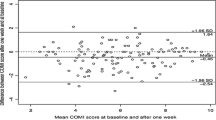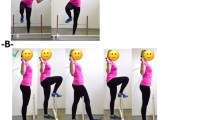Abstract
Background and aims: The Functional Rating Index (FRI) was developed to provide an assessment instrument which has not only clinical usefulness but also quantifies the patient’s current state of pain and dysfunction in a reliable and valid manner for spinal conditions. There is no study on the FRI applied to older people with low back pain (LBP). The primary aim of this study was to evaluate the validity and reliability of the FRI in older people with LBP. Methods: A total of 76 subjects aged 65 to 90 years with LBP, of which 37 were cognitively intact and were followed up on a second occasion, were assessed by the FRI, numeric rating scale (NRS), Roland Morris Questionnaire (RMQ) and spinal movement test. Reliability was assessed by statistical analysis of test results for test-retest and internal consistency. To assess construct validity, the FRI was compared with the RMQ. Concurrent validity was assessed using the NRS and spinal mobility test. Results: The FRI demonstrated high internal consistency, with al-pha=0.921 for test and alpha=0.901 for retest. Item-scale correlations were between 0.549–0.871. Test-retest correlation was 0.913 (p=0.000). There was very good construct validity between the FRI and the RMQ for test (r=0.663, p<0.000) and retest (r=0.603, p<0.000). The FRI showed high correlation with the NRS (r=0.701, p<0.000 for test; r=0.743, p<0.000 for retest) and no correlation with the spinal movement test (r=0.173, p=0.307 for test; r=0.024, p=0.888 for retest). Conclusions: In this preliminary report, the FRI appears to be easy to administer, seems to have significant validity and reliability, and may be useful in geriatric assessment of older people with LBP.
Similar content being viewed by others
References
Brach JS, VanSwearingen JM. Physical impairment and disability: relationship to performance of activities of daily living in community-dwelling older men. Phys Ther 2002; 82: 752–61.
Fried LP, Guralnik JM. Disability in older adults evidence regarding significance, etiology and risk. J Am Geriatr Soc 1997; 45: 92–100.
Ostir GV, Carlson JE, Black SA, Rudkin L, Goodwin JS, Markides KS. Disability in older adults: causes, prevalence and consequences. Behav Med 1999; 24: 147–56.
Reuben DB, Siu AL. An objective measure of physical function of elderly outpatients. The Physical Performance Test. J Am Geriatr Soc 1990; 38: 1105–12.
Guralnik JM, Simonsick EM. Physical disability in older Americans. J Gerontol 1993; 48: 3–10.
Bruce DG, Devine A, Prince RL. Recreational physical activity levels in healthy older women: the importance of fear of falling. J Am Geriatr Soc 2002; 50: 84–9.
Siu AL, Hays RD, Ouslander JG, et al. Measuring functioning and health in the very old. J Gerontol 1993; 48: M10–4.
Shumway-Cook A, Patla AE, Stewart A, Ferrucci L, Ciol MA, Gu-ralnik JM. Environmental demands associated with community mobility in older adults with and without mobility disabilities. Phys Ther 2002; 82: 670–81.
Waddell G, Main CJ, Morris EW, Di Paola M, Gray IC. Chronic low back pain, psychological distress, and illness behaviour. Spine 1984; 9: 209–13.
King MB, Whipple RH, Gruman CA, Judge JO, Schmidt JA, Wolfson LI. The performance enhancement project: improving physical performance in older persons. Arch Phys Med Rehabil 2002; 83: 1060–9.
Lee CE, Simmonds MJ, Novy DM, Jones S. Self-reports and clinician-measured physical function among patients with low back pain: a comparison. Arch Phys Med Rehabil 2001; 82: 227–31.
Feise RJ, Michael Menke J. Functional Rating Index: a new valid and reliable instrument to measure the magnitude of clinical change in spinal conditions. Spine 2001; 26: 78–87.
Ferrell BA, Stein WM, Beck JC. The Geriatric Pain Measure: validity, reliability and factor analysis. J Am Geriatr Soc 2000; 48: 1669–73.
Fritz JM, Irrgang JJ. A comparison of a modified Oswestry Low Back Pain Disability Questionnaire and the Quebec Back Pain Disability Scale. Phys Ther 2001; 81: 776–88.
Jacob T, Baras M, Zeev A, Epstein L. Low back pain: reliability of a set of pain measurement tools. Arch Phys Med Rehabil 2001; 82: 735–42.
Weiner D, Pieper C, McConnell E, Martinez S, Keefe F. Pain measurement in elders with chronic low back pain: traditional and alternative approaches. Pain 1996; 67: 461–7.
Reuben DB, Siu AL, Kimpau S. The predictive validity of self-report and performance-based measures of function and health. J Gerontol 1992; 47: M106–10.
Bressler HB, Keyes WJ, Rochon PA, Badley E. The prevalence of low back pain in the elderly. A systematic review of the literature. Spine 1999; 24: 1813–9.
Epstein AM. The outcome movement. Will it get us where we want to go? N Engl J Med 1990; 323: 266–70.
Portney LG, Watkins MP. Foundation of clinical research. Application to practice. Norwalk, CT: Appleton & Lange, 1993.
Salaffi F, Piva S, Barreca C, et al. Validation of an Italian version of the Arthritis Impact Measurement Scales 2 (Italian AIMS 2) for patients with osteoarthritis of the knee. Rheumatology 2000; 39: 720–7.
Küçükdeveci AA, Tennant A, Elhan AH, Niyazoglu H. Validation of the Turkish version of the Roland-Morris Disability Questionnaire for use in low back pain. Spine 2001; 26: 2738–43.
Author information
Authors and Affiliations
Corresponding author
Rights and permissions
About this article
Cite this article
Bayar, B., Bayar, K., Yakut, E. et al. Reliability and validity of the Functional Rating Index in older people with low back pain: Preliminary report. Aging Clin Exp Res 16, 49–52 (2004). https://doi.org/10.1007/BF03324532
Received:
Accepted:
Published:
Issue Date:
DOI: https://doi.org/10.1007/BF03324532




